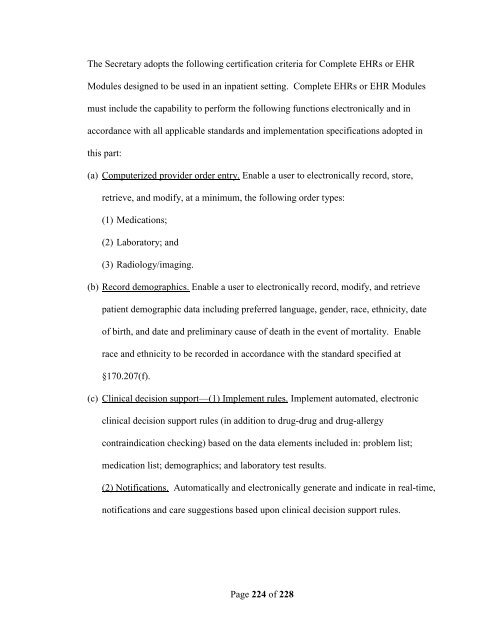ehr onc final certification - Department of Health Care Services
ehr onc final certification - Department of Health Care Services ehr onc final certification - Department of Health Care Services
The Secretary adopts the following certification criteria for Complete EHRs or EHR Modules designed to be used in an inpatient setting. Complete EHRs or EHR Modules must include the capability to perform the following functions electronically and in accordance with all applicable standards and implementation specifications adopted in this part: (a) Computerized provider order entry. Enable a user to electronically record, store, retrieve, and modify, at a minimum, the following order types: (1) Medications; (2) Laboratory; and (3) Radiology/imaging. (b) Record demographics. Enable a user to electronically record, modify, and retrieve patient demographic data including preferred language, gender, race, ethnicity, date of birth, and date and preliminary cause of death in the event of mortality. Enable race and ethnicity to be recorded in accordance with the standard specified at §170.207(f). (c) Clinical decision support—(1) Implement rules. Implement automated, electronic clinical decision support rules (in addition to drug-drug and drug-allergy contraindication checking) based on the data elements included in: problem list; medication list; demographics; and laboratory test results. (2) Notifications. Automatically and electronically generate and indicate in real-time, notifications and care suggestions based upon clinical decision support rules. Page 224 of 228
(d) Electronic copy of health information. (1) Enable a user to create an electronic copy of a patient’s clinical information, including, at a minimum, diagnostic test results, problem list, medication list, medication allergy list, and procedures: (i) In human readable format; and (ii) On electronic media or through some other electronic means in accordance with: (A) The standard (and applicable implementation specifications) specified in §170.205(a)(1) or §170.205(a)(2); and (B) For the following data elements the applicable standard must be used: (1) Problems. The standard specified in §170.207(a)(1) or, at a minimum, the version of the standard specified in §170.207(a)(2); (2) Procedures. The standard specified in §170.207(b)(1) or §170.207(b)(2); (3) Laboratory test results. At a minimum, the version of the standard specified in §170.207(c); and (4) Medications. The standard specified in §170.207(d). (2) Enable a user to create an electronic copy of a patient’s discharge summary in human readable format and on electronic media or through some other electronic means. (e) Electronic copy of discharge instructions. Enable a user to create an electronic copy of the discharge instructions for a patient, in human readable format, at the time of discharge on electronic media or through some other electronic means. Page 225 of 228
- Page 173 and 174: ability of CCD and CCR to support t
- Page 175 and 176: ability to receive these reports. M
- Page 177 and 178: commenters acknowledged and express
- Page 179 and 180: a meaningful use objective they wou
- Page 181 and 182: CMS and ONC had worked together to
- Page 183 and 184: The eligible professional or eligib
- Page 185 and 186: EHR technology with the needs of us
- Page 187 and 188: The RFA requires agencies to analyz
- Page 189 and 190: values seemed low and that the gap
- Page 191 and 192: commenter provided), our assumption
- Page 193 and 194: absolute low we estimated for a per
- Page 195 and 196: number of previously CCHIT-certifie
- Page 197 and 198: for Certification Low High Page 197
- Page 199 and 200: Finally, the third type of cost we
- Page 201 and 202: 2012 15% $10.10 $30.80 $20.45 3-Yea
- Page 203 and 204: The RFA requires agencies to analyz
- Page 205 and 206: The Office of Management and Budget
- Page 207 and 208: The standards and implementation sp
- Page 209 and 210: The Secretary adopts the following
- Page 211 and 212: any edition other than that specifi
- Page 213 and 214: (e) Regenstrief Institute, Inc., LO
- Page 215 and 216: 4. Revise subpart C to read as foll
- Page 217 and 218: smoker; current some day smoker; fo
- Page 219 and 220: (2) Generate audit log. Enable a us
- Page 221 and 222: (3) Medication allergy list; (4) De
- Page 223: §170.205(a)(1) or §170.205(a)(2).
- Page 227 and 228: specifications) specified in §170.
The Secretary adopts the following <strong>certification</strong> criteria for Complete EHRs or EHR<br />
Modules designed to be used in an inpatient setting. Complete EHRs or EHR Modules<br />
must include the capability to perform the following functions electronically and in<br />
accordance with all applicable standards and implementation specifications adopted in<br />
this part:<br />
(a) Computerized provider order entry. Enable a user to electronically record, store,<br />
retrieve, and modify, at a minimum, the following order types:<br />
(1) Medications;<br />
(2) Laboratory; and<br />
(3) Radiology/imaging.<br />
(b) Record demographics. Enable a user to electronically record, modify, and retrieve<br />
patient demographic data including preferred language, gender, race, ethnicity, date<br />
<strong>of</strong> birth, and date and preliminary cause <strong>of</strong> death in the event <strong>of</strong> mortality. Enable<br />
race and ethnicity to be recorded in accordance with the standard specified at<br />
§170.207(f).<br />
(c) Clinical decision support—(1) Implement rules. Implement automated, electronic<br />
clinical decision support rules (in addition to drug-drug and drug-allergy<br />
contraindication checking) based on the data elements included in: problem list;<br />
medication list; demographics; and laboratory test results.<br />
(2) Notifications. Automatically and electronically generate and indicate in real-time,<br />
notifications and care suggestions based upon clinical decision support rules.<br />
Page 224 <strong>of</strong> 228



